Intertrigo is an inflammatory skin condition that arises mainly in the skin folds. Infants and young children are more vulnerable due to their developing skin. Conventional treatments often include topical creams and maintaining skin hygiene.
However, cases of persistent intertrigo raise concerns about the efficacy and potential side effects of these interventions. An 8-month-old infant suffering from persistent intertrigo was administered homeopathic remedies, leading to a remarkable recovery within a week.
The previously employed tea tree oil applications failed to alleviate the symptoms, prompting a shift towards homeopathic intervention. The infant’s rapid recovery suggests that homeopathy may offer a promising alternative for pediatric intertrigo, addressing the condition at its roots. Further research is needed to validate these findings.
Keywords: Erythema intertrigo, intertrigo, diaper dermatitis, classical homeopathy, pediatric skin infections, case report.
Introduction:
Intertrigo is an inflammatory skin condition that arises in skin folds due to a combination of friction and moisture which provides an ideal breeding ground for microorganisms.1 While intertrigo is of concern across all age groups, its occurrence in infants and young children deserves special attention.2 Factors such as diaper use, limited mobility, and an evolving immune system contribute to their heightened susceptibility.
Heat, humidity, and obesity can also contribute to increased sweating and exacerbate the condition.1 Specific pathogens, like Streptococcus, render an added layer of complexity.3 Streptococcus, thriving in warm and moist environments, can exacerbate inflammation and compromise the delicate skin of infants leading to infection.3
Intertrigo commonly affects areas such as the armpits, groin, between the toes, and other skin folds. Clinical manifestations typically include redness, irritation, and discomfort in skin folds, with Streptococcal infection leading to more severe manifestations that require early recognition and intervention.2,4
Clinical assessment, combined with laboratory tests to identify pathogens like Streptococcus, ensures a precise understanding of causative factors.4 The management of intertrigo, particularly when Streptococcus is involved, requires a multifaceted approach.5
This includes the use of topical antimicrobial agents, antibiotics, and meticulous skin care routines tailored to the unique needs of infants, ensuring both efficacy and safety in treatment.6,4 Left untreated, intertrigo can lead to complications such as secondary bacterial infections, systemic involvement, and long-term skin changes.4,2
However, with the escalating challenge of antibiotic resistance, there is a growing need to explore alternative avenues. This case report provides an alternative for the treatment of intertrigo using classical homeopathy.
Case report:
The parents of an 8-month-old boy sought homeopathic treatment on 20/03/2023, reporting skin eruptions for the past 2 months. It began as a rash in the inguinal folds and on the scrotum on 27/01/2023, two days after the family’s return from a holiday at the seacoast. (figure 1) On 19/02/2023, the child developed a high temperature of 39°C and a runny nose for the first time since birth.
The eruptions became more prominent during the fever. The fever persisted for 3 days, during which the child’s general health and appetite remained relatively unaffected. The parents did not administer any medication except for tea tree oil on the affected rash areas.
On 04/03/2023, new eruptions appeared in the gluteal folds and the fold of the right knee (figure 1). The skin in the groin, on the thighs, and the buttocks began peeling and expanded daily. Rashes were moist, painless, and yellow crusts formed along its edges. The dermatologist diagnosed the condition as exudative-catarrhal diathesis complicated by Streptoderma. At this juncture, they sought homeopathic treatment.
Past medical history:
The patient did not have any major illness since birth. His teeth development was slow for his age.
Family history:
- Father- no major illness.
- Mother- recurrent herpes and warts.
Mental/emotional history:
The boy is very cheerful and does not have any fears.
Diagnosis: Erythema Intertrigo (ICD 10-L30.4)7
The symptoms available for prescription were as follows:
- TEETH-DENTITION (teething in children) – slow (+)
- ABDOMEN-FLATULENCE-night (+)
- RECTUM-CONSTIPATION-children, in (++)
- GENITALIA-MALE-ERUPTIONS-Scrotum-moist-between, and thigh (++)
- EXTREMITIES-ERUPTIONS-Fingers-tips of-desquamation (+)
- SKIN-ERUPTIONS-discharging, moist (++)
- SKIN-INTERTRIGO (++)
- GENERALITIES-AIR-open-desire for (++)
- GENERALITIES-SEASHORE, at the-agg (+++)
- SKIN-ERUPTIONS-rash-sunlight agg (++)
Figure 1: photos before treatment.
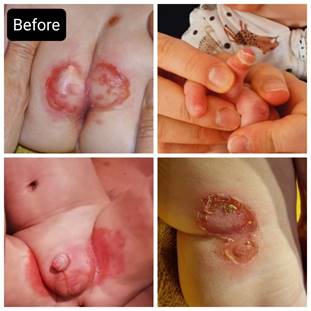
Case analysis and prescription:
In this case, exposure to sun and seashore provoked the development of skin pathology and served as an important etiological factor and rationale for the homeopathic prescription. The study of these characteristic symptoms of the skin and physical general symptoms gave rise to a specific totality of symptoms. (Figure 2)
Figure 2: Reportorial result on 21/03/2023 (Vithoulkas compass)
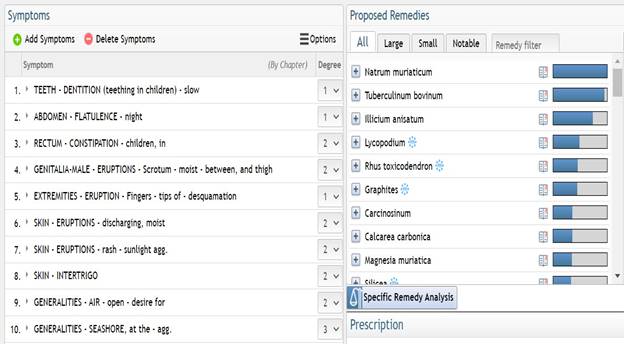
A dose of Natrum muraticum 200CH was prescribed on 21/03/2023.
The follow-up of the case is listed in Table 1.
Table 1: Follow up of the case.
| DATE | SYMPTOMS | ANALYSIS | PRESCRIPTION |
| 28/03/2023 | During the first week after the remedy, the skin improved dramatically. The crusts cleared completely and only redness remained. (figure 3) After few days, the skin healed completely and appeared normal. (figure 4)
Constipation also improved drastically. Flatulence and abdomen pain also improved. |
The patient is doing better both pathologically and generally. We must wait and watch until any new symptoms appear. | Nil |
Figure 3: photos before and after treatment.
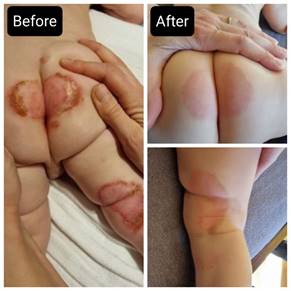
Figure 4: Recent photo after treatment.
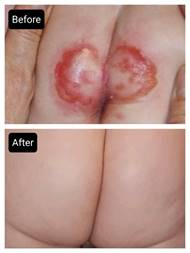
Discussion:
Treating intertrigo in babies poses unique challenges due to the delicate nature of infant skin, which is thinner and more sensitive than in older individuals.1 Additionally, the skin barrier in infants is still developing, and their immune system is not fully matured, making them more vulnerable to infections.6
Prolonged or inappropriate use of corticosteroids in this age group can lead to systemic absorption, potentially resulting in adverse effects such as skin atrophy and systemic side effects.5 This heightened sensitivity increases the risk of adverse reactions to topical treatments, necessitating a careful and gentle therapeutic approach.8
Given the challenges associated with conventional treatments, a holistic approach, such as homeopathy, gains significance in the context of intertrigo in babies.5 Homeopathic intervention with its focus on individualized care and minimal side effects, may offer a safer and more effective alternative to conventional therapies in infants.9,10
In the above case, the child presented with persistent intertrigo majorly in the diaper area, causing discomfort and distress. The parents opted for a homeopathic approach, seeking to avoid potential risks associated with corticosteroids at such a young age.
The child was administered individualized homeopathic remedy based on characteristic symptoms. Within a short period, noticeable improvements were observed in the redness, irritation, and discomfort associated with intertrigo. (Figure 3) Eventually, the skin completely healed without any scarring. (figure 4) The child’s overall well-being also seemed to improve during homeopathic treatment.
Professor George Vithoulkas’ “Levels of Health” theory is organized into four groups (A-D), each consisting of three levels (1-12), offering a comprehensive framework for understanding diseases and their treatment.11,12
In Group A, individuals at Levels 1-3 showcase a higher and more harmonious state of health, characterized by a robust constitution and minimal susceptibility to diseases.11,12 They exhibit positive and instant responses to homeopathic treatment.
The case above belongs to group A with no history of fevers in the past and development of an infectious skin pathology with streptococcal infection. This case illustrates how a correctly chosen homeopathic remedy adhering to the principles of classical homeopathy can have an almost instantaneous healing effect even in such severe skin pathologies in children. (figure 4)
The Modified Naranjo Criteria for Homeopathy (MONARCH) causality assessment provided a score of 10/13, suggesting a significant causal relationship to the treatment (Table 2).13 Previous case studies have demonstrated favourable results for use of classical homeopathy even in instances of severe skin pathologies.14,15,16,17 This case report establishes a basis for further investigation into the advantages of employing classical homeopathy for the management of paediatric skin infections.
Table 2: Modified Naranjo Criteria for Homeopathy (MONARCH) – for causality assessment.
| Criteria | Y | N | Not sure/NA | Score in case |
| 1. Was there an improvement in the main symptom or condition for which the homeopathic medicine was prescribed? | 2 | -1 | 0 | 2 |
| 2. Did the clinical improvement occur within a plausible time frame relative to the drug intake? | 1 | -2 | 0 | 1 |
| 3. Was there an initial aggravation of symptoms? | 1 | 0 | 0 | 0 |
| 4. Did the effect encompass more than the main symptom or condition, i.e., were other symptoms ultimately improved or changed? | 1 | 0 | 0 | 1 |
| 5. Did overall well-being improve? | 1 | 0 | 0 | 1 |
| 6 (A) Direction of cure: did some symptoms improve in the opposite order of the development of symptoms of the disease? | 1 | 0 | 0 | 1 |
| 6 (B) Direction of cure: did at least two of the following aspects apply to the order of improvement of symptoms: from organs of more importance to those of less importance, from deeper to more superficial aspects of the individual, from the top downwards | 1 | 0 | 0 | 1 |
| 7. Did “old symptoms” (defined as non-seasonal and non-cyclical symptoms that were previously thought to have resolved) reappear temporarily during the course of improvement? | 1 | 0 | 0 | 0 |
| 8. Are there alternate causes (other than the medicine) that with a high probability could have caused the improvement? (consider known course of disease, other forms of treatment, and other clinically relevant interventions) | -3 | 1 | 0 | 1 |
| 9. Was the health improvement confirmed by any objective evidence? (photos before and after treatment) | 2 | 0 | 0 | 2 |
| 10. Did repeat dosing, if conducted, create similar clinical improvement? | 1 | 0 | 0 | 0 |
| Total | 10 |
Conclusion:
The case discussed above suggests that homeopathy can offer a rapid and effective alternative, especially in infants. The limitations associated with corticosteroid use in babies highlights the importance of careful consideration and exploration of alternative treatments, emphasizing the need for further research on optimal approaches to pediatric skin conditions.
References:
- Nobles T, Miller RA. Intertrigo. Inpatient Dermatology. Published online September 19, 2022:391-393. doi:10.1007/978-3-319-18449-4_79
- Voegeli D. Intertrigo: Causes, prevention and management. Br J Nurs. 2020;29(12):S16-S22. doi:10.12968/bjon.2020.29.12.s16
- Neri I, Bassi A, Patrizi A. Streptococcal intertrigo. J Pediatr. 2015;166(5):1318. doi:10.1016/J.JPEDS.2015.01.031
- Castilho S, Ferreira S, Fortunato F, Santos S. Intertrigo of streptococcal aetiology: A different kind of diaper dermatitis. BMJ Case Rep. 2018;2018. doi:10.1136/bcr-2018-224179
- Janoušková K, Sikorová L. Diaper Dermatitis. Pediatr pro Praxi. 2023;20(1):46-48. doi:10.1177/000992288802700907
- Block SL. Tricky triggers of intertrigo. Pediatr Ann. 2014;43(5):171-176. doi:10.3928/00904481-20140417-04
- 2024 ICD-10-CM Diagnosis Code L30.4: Erythema intertrigo. Accessed January 16, 2024. https://www.icd10data.com/ICD10CM/Codes/L00-L99/L20-L30/L30-/L30.4
- Neri I, Bassi A, Patrizi A. Streptococcal intertrigo. J Pediatr. 2015;166(5):1318. doi:10.1016/j.jpeds.2015.01.031
- Hanhemann S. Organon of Medicine. B.Jain publishers; 1994.
- Kent JT. Kent’S Lectures on Homoeopathic Philosophy. B.Jain publishers; 2002. https://www.naturopathicmedicineinstitute.org/wp-content/uploads/2016/09/Lectures-on-Homeopathic-Philosophy.pdf
- Vithoulkas G. Levels of Health.; 2017.
- Vithoulkas G and Tiller.w. The Science of Homeopathy. 7th Edition.; 2014.
- Lamba CD, Gupta VK, Van Haselen R, et al. Evaluation of the Modified Naranjo Criteria for Assessing Causal Attribution of Clinical Outcome to Homeopathic Intervention as Presented in Case Reports. Homeopathy. 2020;109(4):191-197. doi:10.1055/s-0040-1701251
- Mahesh S, Kozymenko T, Kolomiiets N, Vithoulkas G. Antimonium crudum in pediatric skin conditions: A classical homeopathic case series. Clin case reports. 2020;9(2):818-824. doi:10.1002/CCR3.3674
- Mahesh S, Shah V, Mallappa M, Vithoulkas G. Psoriasis cases of same diagnosis but different phenotypes—Management through individualized homeopathic therapy. Clin Case Reports. 2019;7(8):1499-1507. doi:10.1002/CCR3.2197
- Mahesh S, Mallappa M, Habchi O, et al. Appearance of Acute Inflammatory State Indicates Improvement in Atopic Dermatitis Cases Under Classical Homeopathic Treatment: A Case Series. Clin Med Insights Case Reports. 2021;14. doi:10.1177/1179547621994103/ASSET/IMAGES/LARGE/10.1177_1179547621994103-FIG9.JPEG
- Vithoulkas G, Mahesh S, Mallappa M. Gangrene: Five case studies of gangrene, preventing amputation through Homoeopathic therapy. Indian J Res Homoeopath. 2015;9(2):114. doi:10.4103/0974-7168.159544






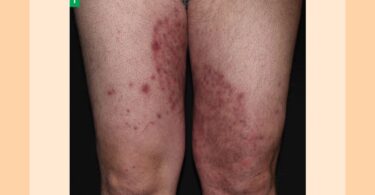
Thank you for this well analyzed and finely managed case.